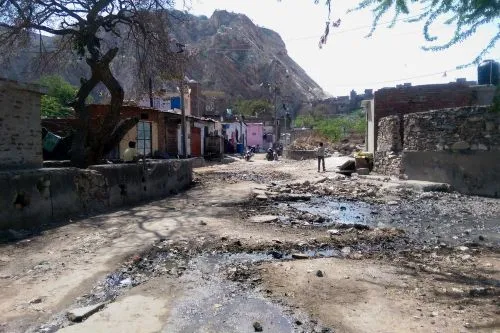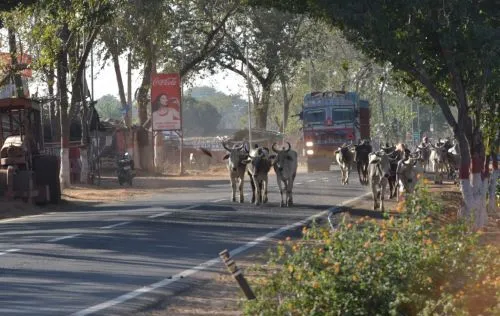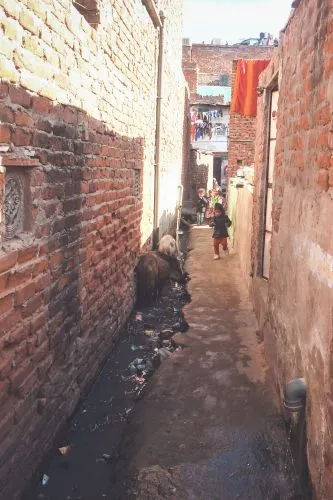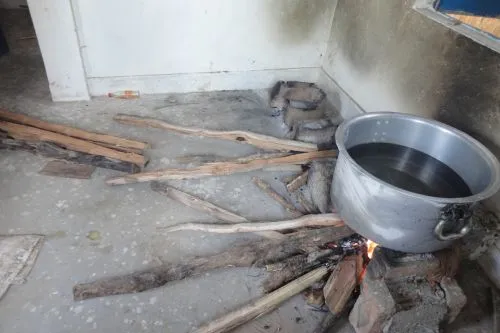India grounded: Covid-19 poses gigantic challenges
Part 1: Covid-19 seems to reveal India’s weak spots.
Blog post by Namrata Rawat*)
The COVID- 19 pandemic has the entire world in its grip and left many nations’ health systems struggling with enormous challenges. India has also started to deal with the consequences of the disease, claiming more than 200,000 lives worldwide to date.
Public life at a standstill, health system in crisis
In India, the number of COVID-19 cases has increased since recording started in March 2020, totaling 29,435 infection cases and 934 deaths by now (April 28, 2020)1. So the intensity of the pandemic is not as grave yet in India as in other countries. This might partially be attributed to the very limited scale of testing conducted in the country. To buy more time to prepare for and contain the spread, India has imposed a complete and nation-wide lockdown for the period 24 March - May 3. This has brought public life in all its 28 federal states and eight Union territories to an abrupt halt. Air travels in and out of India were suspended at an earlier stage, but with the nation-wide lockdown all domestic travels have been suspended too. Indian Railways, being the country’s lifeline, has seen its first ever suspension of services since its foundation 167 years ago. Only essential services remain open whereas all other utilities, businesses and activities are suspended. No one has the permission to step out of their house except in cases of absolute necessity to get groceries or for health emergencies. Only people working in essential services can go out to work in addition to those with special permissions and passes. In various locations identified as hotspots, even essential services are shut down. Health emergency and groceries are being delivered through a system administered by the police. However, the medical frontline workers along with others involved in providing essential state services such as law and order continue to suffer from an acute shortage of Personal Protective Equipment.

Humanitarian crisis in the middle of a pandemic
The suddenly imposed lockdown created massive panic among India’s citizens. Most metropolitan cities and small towns saw a mad rush to markets to grab rations, medicines and other necessary articles. One day after it had been announced that essential services would remain open the panic in cities eased off. However, the complete lockdown of the country has brought about a major humanitarian crisis. The majority of the population in India lives from hand-to-mouth and cannot afford the privilege of staying home. We are talking about migrant laborers in cities, daily-wage-earners pulling rickshaws, people working in factories, domestic helpers and the homeless. All these people face more or less two options: either continue to work therewith risking contract the disease or stay at home and risking starvation. If they stay home they are out of work without any savings to rely on. Factory workers are unemployed too, factories being closed and middle-class gated communities have been closing their gates as well.
Millions of Indian citizens on the move
Consequently, after a complete national lockdown was announced, India has witnessed a massive exodus and internal migration of seasonal migrants, mostly from cities back to rural areas. According to some reports it is the largest migration within the country since India’s independence from British rule in 1947 and the ensuing partition from Pakistan. Since all transportation had been shut down with the lockdown, thousands of men, women, children, and elderly walked to their villages on foot, sometimes up to hundreds of kilometers. Many couldn’t make it all the way walking and passed away, others have been put into quarantine centers along the road. However, the treatment they have got in these centers has not been the same as Indian citizens received who returned or evacuated from abroad because of the pandemic outbreak. People living below the poverty line have been assured of financial state support but that’s not without its own share of problems. Some recent attempts to withdraw this paltry sum of 500 rupees (6.6 $) have created big gatherings of people who were flouting the social distancing rules, especially in small towns and villages.

Social stigma and racism
Those who were not put in quarantine centers before they could reach their hometowns and villages were often not allowed to enter. The villagers were afraid of ‘outsiders’ bringing the infection with them. The issue of stigmatization is not restricted to poor migrants. Even doctors, nurses, and other people working at the medical frontline, as well as airlines’ personnel involved in rescuing Indians stuck abroad and many other essential service providers are reporting that they are increasingly being harassed. They report that people in their home communities want them to vacate housing complexes for the time they are involved in protecting the country from the pandemic. After many positive cases were traced to a religious gathering, that entire community is being targeted in the country in similar or even more inhumane manner.

Side-effects of the spread of social media
Panic, paranoia and hatred, easily spread in India throughout social media, especially WhatsApp, are emerging as another huge issue impeding the work of the state administration. Fake news is therefore being handled in a stricter way now. WhatsApp has responded by making its rules for forwarding messages more stringent and police is also cracking down on people spreading messages colored with communal hate. A country as diverse in its culture, eating habits, social norms and cultural life as India faces another social problem as the racist terminology for Covid-19-turned-into-‘Chinese Virus’ has become popular. This has led to the harassing of people from the North East of India, generally coming from mountain communities, and sometimes have similar features as Han Chinese. Incidents of people hurling racial slurs like ‘corona virus’ at them, asking them in demeaning manner to ‘stay at home’ in super markets (before the lockdown was imposed) and asking them to evict their houses has added another layer of social discrimination and harassment.
Social distancing and distances: India’s bitter social reality
It is often said that ‘real India’ is composed by villages and small towns and not by metropolitan cities. However, during lockdown, it’s the marginalized Indians everywhere, be it in villages, small towns and urban settings who are suffering most and have become even more prone to poverty and hunger. While poverty and hunger have always been part of India’s public life, the pandemic has disclosed the vast disparity between its rich, comfortable middle class and its poor, homeless, daily-wage-earning, vulnerable class. The government’s failure to respond in a sensitive and more coherent way, has also created a rift in public sentiments. Some are advocating for stricter implementation and punishment for migrants on the roads, whereas others are calling for the state to take more responsibility and step up as the guardian of those citizens who cannot afford to just stay home.
While the poor are on the roads, walking long distances to somehow reach their ‘home’ in the villages, or have ended up being confined in quarantine centers, the middle class has been confined to working from home where waiting for long delivery slots from e-commerce service providers like Amazon, Walmart, etc. seems to be the largest challenge.
Resilience, innovation and helping hands
One thing that keeps the poor in India going is their resilience and ability to innovate in the direst of situations and come up with solutions. This time is no different: many young, new start-ups have come up with indigenous solutions to produce testing kits, Personal Protective Equipment and even medical equipment like ventilators. They struggle with the slow bureaucratic processes and delays at the state’s end to clear supply orders but are hopeful they can meet the demands of the situation if they are supported with relaxations in dealing with the lockdown. Looking at the unplanned and hastily implemented provisions of the lockdown, many non-profits, civil society organizations and individuals have taken on to help people who are suffering during this lockdown. They collect rations from those who can donate and deliver them to the poor, homeless and stranded laborers. They help the elderly who are living on their own receive essential goods. Several Resident Welfare Associations are taking care of their live-in staff. Young people are raising funds through crowdfunding portals and social media platforms to help and feed those in need. Some people have started initiatives to feed stray animals. The array of this kind of citizen initiatives have been comforting in times when panic and apathy are aplenty.

Hope to pick lessons for reforms
India is the second most populated country in the world with its 1.3 billion inhabitants. Its public health infrastructure has been due for massive reform for many years now. India spends only 1.28% of its Gross Domestic Product (GDP) on public health2. This is lower than most countries classified as Lower Income by the World Bank, who spend 1.57% of their GDP on public health. India ranks 184 out of 191 countries in terms of share of GDP spent on healthcare, according to the World Health Organization (2017-18). Poor people in India have always been aware of this state of the public health system. As for India’s middle class, it has come as a revelation, as they are forced to take refuge to the public healthcare system now too, as private healthcare resources have not been made available for treating COVID-19 cases so far. The poor have always struggled with shortage of hospitals, doctors, beds and ventilators and succumbed to diseases like pneumonia, respiratory infections and diarrhea3. A broader part of the population is starting to realize this only now, with the pandemic on the horizon. One hopes that after we have sailed through this crisis that has brought even nations with well-founded, strongly established healthcare systems to their knees, we will focus on richer and better planned investments in our public healthcare system. We also look forward towards a better social security system that safeguards basic but dignified living conditions for all its citizens and a minimum healthcare system providing for all. The ‘everyone for themselves’ model implemented so far has landed us in these perilously disadvantaged circumstances. One hopes for more consciousness of citizens and a stronger conscience among policy makers.
*) The author is a doctoral student at ZEF.
1) www.mohfw.gov.in
2) theprint.in/health/at-1-28-gdp-india-expenditure-on-health-still-low-although-higher-than-before/313702/
3) www.cbhidghs.nic.in/index1.php
More can be read about the situation here:
https://www.dw.com/en/coronavirus-lockdown-delhi-struggles-to-feed-migrants-left-behind/a-53015294


